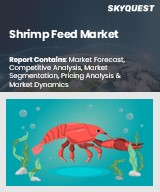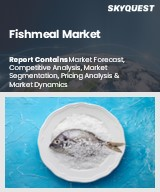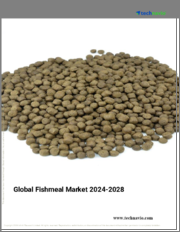
|
시장보고서
상품코드
1813324
세계의 어분 시장 : 예측 - 공급원별, 가축별, 용도별, 지역별 분석(-2032년)Fish Meal Market Forecasts to 2032 - Global Analysis By Source (Whole Fish and By-Product), Livestock, Application and By Geography |
||||||
Stratistics MRC에 따르면 세계의 어분 시장은 2025년에 110억 달러로 추정되고, 예측 기간 동안 CAGR 8.3%로 성장할 전망이며, 2032년에는 192억 달러에 이를 것으로 예측됩니다.
어분은 생선과 생선 제품별 조직을 조리, 건조, 분쇄한 영양이 풍부한 사료 원료입니다. 어분은 고단백질(일반적으로 60-72%)에서 필수 아미노산을 포함하기 때문에 동물 영양, 특히 수산 양식, 가금, 가축에 주로 사용됩니다. 어분에는 칼슘과 인과 같은 귀중한 미네랄과 성장과 면역력을 지원하는 오메가3 지방산도 포함되어 있습니다. 생선은 식용에 적합하지 않은 물고기와 생선 가공 폐기물로 만들어집니다. 소화가 좋고 영양소가 농축되어 사료 효율을 높이고 동물의 건전한 발육을 촉진하는 데 적합합니다.
수산 양식 수요 증가
수산 양식의 급속한 확장은 세계의 단백질 공급망을 재구성하고 어분을 고기능 수산 사료의 핵심으로 자리 매김하고 있습니다. 양식 어패류가 천연 어패류를 추월하는 가운데, 생산자는 그 타의 추종을 불허하는 소화성, 아미노산 프로파일, 성장 촉진 특성으로부터 어분에 신뢰를 기울이고 있습니다. 아시아와 라틴아메리카는 수산물 소비 증가 및 수출 지향 양식으로 이 급성장을 이끌고 있습니다. 동시에 지속가능성 요청이 사료 제조업체에게 배합의 최적화를 촉구하고 정밀영양과 환경을 배려한 양식 시스템에서 어분의 역할이 강화되고 있습니다.
남획 및 환경에 대한 우려
어분의 생산은 남획 및 환경 악화에 의해 현저하게 방해되고 있습니다. 밀 추출을 목적으로 하는 야생어 자원의 지속 불가능한 채취로 해양의 생물 다양성과 규제 준수가 위기에 처해 있습니다. 생산자는 환경 문제에 대한 감시와 어획 프레임의 엄격화로 대체 원료의 사용과 순환 조달 전략을 강요받고 있습니다. 이러한 우려로 인해 제품별 및 식물 유래 대체 원료를 사용하는 경향이 강해지고 있으며, 특히 섬세한 해양 생태계를 가진 지역에서는 기존의 어분 공급망 및 비용 구조에 영향을 미칠 수 있습니다.
영양면에서의 이점
어분은 영양가가 높고, 특히 고품질의 단백질, 오메가3계, 미량 미네랄이 포함되어 있기 때문에 고급 동물 영양학의 요점이 되고 있습니다. 탁월한 소화성은 가금류, 돼지, 양식 시스템에서 급속한 성장, 면역력 향상, 최적의 사료 전환을 지원합니다. 세계적인 단백질 수요가 증가함에 따라, 어분은 고급 사료 첨가제, 특히 성능 향상을 위한 배합 사료로 인기를 끌고 있습니다. 효소적 가수분해 및 마이크로캡슐화의 새로운 기술은 기능성 사료에서 어분의 역할을 확대하여 어종에 관계없이 표적을 좁힌 공급과 영양 보유를 강화할 수 있습니다.
가격 변동
가격 변동은 여전히 어분 시장에 심각한 위협이며, 이는 원료 가용성 변동, 계절적 어획량 변동, 지정학적 혼란에 기인합니다. 특히 페루와 같은 독수리가 풍부한 지역에서는 공급망 취약성이 급격한 가격 변동을 유발하여 축산 및 양식 생산자의 사료 비용 구조에 영향을 미칠 수 있습니다. 게다가 대체 단백질과의 경쟁과 해양 자원 관리를 둘러싼 규제의 변화는 가격 불안정성을 악화시켜 장기 조달 전략과 금리 예측 가능성에 어려움을 야기하고 시장 확대를 방해할 수 있습니다.
COVID-19의 영향
COVID-19의 대유행은 세계의 어분 공급망을 혼란시켜 생산, 물류, 수요 사이클에 영향을 주었습니다. 운영 중단 및 항구 폐쇄는 어업 활동의 하락과 출하 지연으로 이어졌으며, 사료 제조업체는 노동력 부족과 재고 제약에 직면했습니다. 하지만 팬데믹 후 양식 및 축산 부문의 회복으로 수요가 재연되고 탄력적인 조달과 디지털 추적성이 다시 중시되게 되었습니다. 이 위기는 또한 지속가능하고 현지산 사료 원료에 대한 관심을 가속화하고 조달 우선순위를 재구성했습니다.
예측 기간 동안 닭고기 부문이 최대가 될 전망
높은 단백질 사료 첨가물에 대한 안정적인 수요로 인해 예측 기간 동안 닭고기 부문이 가장 큰 시장 점유율을 차지할 것으로 예측됩니다. 어분은 가금류의 성장률, 계란 생산량, 내병성을 높이기 위해 생산자들 사이에서 선호되는 보충제입니다. 합리적인 가격과 식생활의 변화로 세계적인 닭고기 소비가 증가함에 따라 사료 제조업체는 균형 잡힌 배합에 생선을 통합하는 경향을 강화하고 있습니다. 어분의 높은 영양가 및 비용 성능은 집약적인 가금류 시스템에서 어분의 역할을 확고하게 합니다.
예측 기간 동안 CAGR이 가장 높을 것으로 예상되는 것은 비료 분야입니다.
예측 기간 동안 유기 및 바이오 농업 투입물에 대한 관심 증가로 비료 분야가 가장 높은 성장률을 보일 것으로 예측됩니다. 어분은 질소가 풍부한 조성을 가지므로 토양 개량제로서 효과적이며 식물의 건강과 미생물의 활성을 촉진합니다. 지속가능한 농업 실천이 특히 원예나 특수작물로 지지를 모으면서, 어분 기반의 비료는 합성제품을 대체하는 환경친화적인 것으로 대두되고 있습니다. 유기 인증 및 순환형 농업에 대한 규제 당국의 지원이 이 성장 궤도를 더욱 가속화하고 있습니다.
최대 점유율을 차지하는 지역 :
예측 기간 동안 왕성한 양식 활동, 식육 소비 증가, 사료 생산 능력 확대로 아시아태평양이 가장 큰 시장 점유율을 차지할 것으로 예측됩니다. 중국, 인도, 베트남과 같은 국가들은 집약적인 양식 시스템과 단백질이 풍부한 식단에 대한 중간층 수요가 증가함에 따라 어분의 주요 소비국이 되었습니다. 양식 인프라와 사료 기술 혁신에 대한 정부 투자는 이 지역의 우위를 강화하고 있습니다. 또한 주요 어분 생산 기지에 가깝기 때문에 공급망 효율도 향상되었습니다.
CAGR이 가장 높은 지역 :
예측 기간 동안 사료 가공 진행, 지속 가능한 수산 양식 채용 증가, 유기 비료 수요 증가로 북미가 가장 높은 CAGR을 나타낼 것으로 예측됩니다. 대체 단백질 공급원 및 추적 가능한 사료 원료에 대한 규제 지원은 기술 혁신을 촉진합니다. 이 지역에서는 동물복지와 정밀 영양이 중시되어 고급 사료배합에 있어서 어분의 사용량이 증가하고 있습니다. 국내 생산과 수입 다양화에 대한 전략적 투자도 시장 가속화에 기여하고 있습니다.
무료 주문을 받아서 만드는 서비스 :
이 보고서를 구독하는 고객은 다음 무료 맞춤설정 옵션 중 하나를 사용할 수 있습니다.
- 기업 프로파일
- 추가 시장 기업의 종합적 프로파일링(3개사까지)
- 주요 기업의 SWOT 분석(3개사까지)
- 지역 세분화
- 고객의 관심에 응한 주요국 시장 추계, 예측 및 CAGR(주 : 타당성 확인에 따름)
- 경쟁 벤치마킹
- 제품 포트폴리오, 지리적 존재, 전략적 제휴에 기반한 주요 기업 벤치마킹
목차
제1장 주요 요약
제2장 서문
- 개요
- 이해관계자
- 조사 범위
- 조사 방법
- 데이터 마이닝
- 데이터 분석
- 데이터 검증
- 조사 접근
- 조사 자료
- 1차 조사 자료
- 2차 조사 정보원
- 전제조건
제3장 시장 동향 분석
- 성장 촉진요인
- 성장 억제요인
- 기회
- 위협
- 용도 분석
- 신흥 시장
- COVID-19의 영향
제4장 Porter's Five Forces 분석
- 공급기업의 협상력
- 구매자의 협상력
- 대체품의 위협
- 신규 참가업체의 위협
- 경쟁 기업간 경쟁 관계
제5장 세계의 어분 시장 : 공급원별
- 통물고기
- 제품
제6장 세계의 어분 시장 : 축산별
- 가금
- 돼지
- 반추 동물
- 수생 동물
- 반려 동물
- 기타 가축
제7장 세계의 어분 시장 : 용도별
- 동물 사료
- 비료
- 기타 용도
제8장 세계의 어분 시장 : 지역별
- 북미
- 미국
- 캐나다
- 멕시코
- 유럽
- 독일
- 영국
- 이탈리아
- 프랑스
- 스페인
- 기타 유럽
- 아시아태평양
- 일본
- 중국
- 인도
- 호주
- 뉴질랜드
- 한국
- 기타 아시아태평양
- 남미
- 아르헨티나
- 브라질
- 칠레
- 기타 남미
- 중동 및 아프리카
- 사우디아라비아
- 아랍에미리트(UAE)
- 카타르
- 남아프리카
- 기타 중동 및 아프리카
제9장 주요 발전
- 계약, 파트너십, 협업 및 합작투자
- 인수 및 합병
- 신제품 발매
- 사업 확대
- 기타 주요 전략
제10장 기업 프로파일링
- Austevoll Seafood ASA
- Copeinca ASA
- Corpesca SA
- Omega Protein Corporation
- The Scoular Company
- FF Skagen A/S
- Pesquera Diamante SA
- Oceana Group Limited
- Camanchaca SA
- TripleNine Group A/S
- Pesquera Centinela SA
- Daybrook Fisheries, Inc.
- Kodiak Fishmeal Company
- Havsbrun Sp/f
- Rongcheng Blue Ocean Marine Bio Co., Ltd.
- Baiyang Investment Group, Inc.
- Marvesa Holdings NV
According to Stratistics MRC, the Global Fish Meal Market is accounted for $11.0 billion in 2025 and is expected to reach $19.2 billion by 2032 growing at a CAGR of 8.3% during the forecast period. Fish meal is a nutrient-rich feed ingredient made from the cooked, dried, and ground tissues of fish or fish by-products. It is primarily used in animal nutrition, especially for aquaculture, poultry, and livestock, due to its high protein content (typically 60-72%) and essential amino acids. Fish meal also contains valuable minerals like calcium and phosphorus, along with omega-3 fatty acids that support growth and immunity. It is produced from whole fish not suitable for human consumption or from fish processing waste. Its digestibility and concentrated nutrients make it a preferred choice for enhancing feed efficiency and promoting healthy animal development.
Market Dynamics:
Driver:
Rising Demand from Aquaculture
The rapid expansion of aquaculture is reshaping global protein supply chains, positioning fish meal as a cornerstone in high-performance aqua feeds. As farmed seafood overtakes wild catch, producers rely on fish meal for its unmatched digestibility, amino acid profile, and growth-enhancing properties. Asia and Latin America lead this surge, driven by rising seafood consumption and export-oriented farming. Simultaneously, sustainability imperatives are prompting feed manufacturers to optimize formulations, reinforcing fish meal's role in precision nutrition and environmentally responsible aquaculture systems.
Restraint:
Overfishing and Environmental Concerns
The production of fish meal is severely hampered by overfishing and environmental degradation. Marine biodiversity and regulatory compliance are at risk due to the unsustainable collection of wild fish stocks for the purpose of extracting meal. Producers are under pressure to use alternative raw materials and circular sourcing strategies due to environmental scrutiny and tightened quotas. These worries are driving a trend toward the use of byproducts and plant-based alternatives, which could have an effect on conventional fish meal supply chains and cost structures, particularly in areas with delicate marine ecosystems.
Opportunity:
Nutritional Benefits
Fish meal's nutritional density-particularly its high-quality proteins, omega-3s, and trace minerals-makes it a cornerstone in advanced animal nutrition. Its exceptional digestibility supports rapid growth, improved immunity, and optimal feed conversion in poultry, swine, and aquaculture systems. As global protein demand intensifies, fish meal is gaining traction as a premium feed additive, especially in performance-enhancing formulations. Emerging technologies in enzymatic hydrolysis and microencapsulation are expanding its role in functional feeds, enabling targeted delivery and enhanced nutrient retention across species.
Threat:
Price Volatility
Price volatility remains a critical threat to the fish meal market, driven by fluctuating raw material availability, seasonal catch variations, and geopolitical disruptions. Supply chain fragility-particularly in anchovy-rich regions like Peru-can trigger sharp price swings, impacting feed cost structures for livestock and aquaculture producers. Additionally, competition from alternative proteins and regulatory shifts around marine resource management may exacerbate pricing instability, challenging long-term procurement strategies and margin predictability, thus it hinders the market expansion.
Covid-19 Impact
The COVID-19 pandemic disrupted global fish meal supply chains, affecting production, logistics, and demand cycles. Lockdowns and port closures led to reduced fishing activity and delayed shipments, while feed manufacturers faced labor shortages and inventory constraints. However, post-pandemic recovery in aquaculture and livestock sectors has reignited demand, with renewed emphasis on resilient sourcing and digital traceability. The crisis also accelerated interest in sustainable and locally sourced feed ingredients, reshaping procurement priorities.
The poultry segment is expected to be the largest during the forecast period
The poultry segment is expected to account for the largest market share during the forecast period, due to its consistent demand for high-protein feed additives. Fish meal enhances growth rates, egg production, and disease resistance in poultry, making it a preferred supplement among producers. As global poultry consumption rises-driven by affordability and dietary shifts-feed manufacturers are increasingly incorporating fish meal into balanced formulations. Its nutritional efficacy and cost-performance ratio solidify its role in intensive poultry farming systems.
The fertilizers segment is expected to have the highest CAGR during the forecast period
Over the forecast period, the fertilizers segment is predicted to witness the highest growth rate, due to growing interest in organic and bio-based agricultural inputs. Fish meal's nitrogen-rich composition makes it an effective soil amendment, promoting plant health and microbial activity. As sustainable farming practices gain traction, especially in horticulture and specialty crops, fish meal-based fertilizers are emerging as eco-friendly alternatives to synthetic products. Regulatory support for organic certification and circular agriculture further amplifies this growth trajectory.
Region with largest share:
During the forecast period, the Asia Pacific region is expected to hold the largest market share due to robust aquaculture activity, rising meat consumption, and expanding feed manufacturing capacity. Countries like China, India, and Vietnam are major consumers of fish meal, driven by their intensive farming systems and growing middle-class demand for protein-rich diets. Government investments in aquaculture infrastructure and feed innovation are reinforcing regional dominance. Additionally, proximity to key fish meal production hubs enhances supply chain efficiency.
Region with highest CAGR:
Over the forecast period, the North America region is anticipated to exhibit the highest CAGR, owing to advancements in feed processing, rising adoption of sustainable aquaculture, and increasing demand for organic fertilizers. Regulatory support for alternative protein sources and traceable feed ingredients is fostering innovation. The region's emphasis on animal welfare and precision nutrition is boosting fish meal usage in premium feed formulations. Strategic investments in domestic production and import diversification are also contributing to accelerated market expansion.
Key players in the market
Some of the key players profiled in the Fish Meal Market include Austevoll Seafood ASA, Copeinca ASA, Corpesca S.A., Omega Protein Corporation, The Scoular Company, FF Skagen A/S, Pesquera Diamante S.A., Oceana Group Limited, Camanchaca S.A., TripleNine Group A/S, Pesquera Centinela S.A., Daybrook Fisheries, Inc., Kodiak Fishmeal Company, Havsbrun Sp/f, Rongcheng Blue Ocean Marine Bio Co., Ltd., Baiyang Investment Group, Inc. and Marvesa Holdings N.V.
Key Developments:
In March 2024, Camanchaca's partnership with IBM Food Trust integrates blockchain technology to ensure full traceability of its salmon products. This initiative enhances transparency across the supply chain, empowering consumers with verified data on origin, sustainability practices, and environmental impact from sea to shelf.
In November 2023, Baiyang Investment Group formed a strategic alliance with leading Chinese universities and biotech firms to advance precision aquaculture. The collaboration focuses on AI-driven feed efficiency and early disease detection, aiming to boost sustainability, productivity, and resilience across China's aquaculture sector.
Sources Covered:
- Whole Fish
- By-Product
Livestocks Covered:
- Poultry
- Swine
- Ruminants
- Aquatic Animals
- Pets
- Other Livestocks
Applications Covered:
- Animal Feed
- Fertilizers
- Other Applications
Regions Covered:
- North America
- US
- Canada
- Mexico
- Europe
- Germany
- UK
- Italy
- France
- Spain
- Rest of Europe
- Asia Pacific
- Japan
- China
- India
- Australia
- New Zealand
- South Korea
- Rest of Asia Pacific
- South America
- Argentina
- Brazil
- Chile
- Rest of South America
- Middle East & Africa
- Saudi Arabia
- UAE
- Qatar
- South Africa
- Rest of Middle East & Africa
What our report offers:
- Market share assessments for the regional and country-level segments
- Strategic recommendations for the new entrants
- Covers Market data for the years 2024, 2025, 2026, 2028, and 2032
- Market Trends (Drivers, Constraints, Opportunities, Threats, Challenges, Investment Opportunities, and recommendations)
- Strategic recommendations in key business segments based on the market estimations
- Competitive landscaping mapping the key common trends
- Company profiling with detailed strategies, financials, and recent developments
- Supply chain trends mapping the latest technological advancements
Free Customization Offerings:
All the customers of this report will be entitled to receive one of the following free customization options:
- Company Profiling
- Comprehensive profiling of additional market players (up to 3)
- SWOT Analysis of key players (up to 3)
- Regional Segmentation
- Market estimations, Forecasts and CAGR of any prominent country as per the client's interest (Note: Depends on feasibility check)
- Competitive Benchmarking
- Benchmarking of key players based on product portfolio, geographical presence, and strategic alliances
Table of Contents
1 Executive Summary
2 Preface
- 2.1 Abstract
- 2.2 Stake Holders
- 2.3 Research Scope
- 2.4 Research Methodology
- 2.4.1 Data Mining
- 2.4.2 Data Analysis
- 2.4.3 Data Validation
- 2.4.4 Research Approach
- 2.5 Research Sources
- 2.5.1 Primary Research Sources
- 2.5.2 Secondary Research Sources
- 2.5.3 Assumptions
3 Market Trend Analysis
- 3.1 Introduction
- 3.2 Drivers
- 3.3 Restraints
- 3.4 Opportunities
- 3.5 Threats
- 3.6 Application Analysis
- 3.7 Emerging Markets
- 3.8 Impact of Covid-19
4 Porters Five Force Analysis
- 4.1 Bargaining power of suppliers
- 4.2 Bargaining power of buyers
- 4.3 Threat of substitutes
- 4.4 Threat of new entrants
- 4.5 Competitive rivalry
5 Global Fish Meal Market, By Source
- 5.1 Introduction
- 5.2 Whole Fish
- 5.3 By-Product
6 Global Fish Meal Market, By Livestock
- 6.1 Introduction
- 6.2 Poultry
- 6.3 Swine
- 6.4 Ruminants
- 6.5 Aquatic Animals
- 6.6 Pets
- 6.7 Other Livestocks
7 Global Fish Meal Market, By Application
- 7.1 Introduction
- 7.2 Animal Feed
- 7.3 Fertilizers
- 7.4 Other Applications
8 Global Fish Meal Market, By Geography
- 8.1 Introduction
- 8.2 North America
- 8.2.1 US
- 8.2.2 Canada
- 8.2.3 Mexico
- 8.3 Europe
- 8.3.1 Germany
- 8.3.2 UK
- 8.3.3 Italy
- 8.3.4 France
- 8.3.5 Spain
- 8.3.6 Rest of Europe
- 8.4 Asia Pacific
- 8.4.1 Japan
- 8.4.2 China
- 8.4.3 India
- 8.4.4 Australia
- 8.4.5 New Zealand
- 8.4.6 South Korea
- 8.4.7 Rest of Asia Pacific
- 8.5 South America
- 8.5.1 Argentina
- 8.5.2 Brazil
- 8.5.3 Chile
- 8.5.4 Rest of South America
- 8.6 Middle East & Africa
- 8.6.1 Saudi Arabia
- 8.6.2 UAE
- 8.6.3 Qatar
- 8.6.4 South Africa
- 8.6.5 Rest of Middle East & Africa
9 Key Developments
- 9.1 Agreements, Partnerships, Collaborations and Joint Ventures
- 9.2 Acquisitions & Mergers
- 9.3 New Product Launch
- 9.4 Expansions
- 9.5 Other Key Strategies
10 Company Profiling
- 10.1 Austevoll Seafood ASA
- 10.2 Copeinca ASA
- 10.3 Corpesca S.A.
- 10.4 Omega Protein Corporation
- 10.5 The Scoular Company
- 10.6 FF Skagen A/S
- 10.7 Pesquera Diamante S.A.
- 10.8 Oceana Group Limited
- 10.9 Camanchaca S.A.
- 10.10 TripleNine Group A/S
- 10.11 Pesquera Centinela S.A.
- 10.12 Daybrook Fisheries, Inc.
- 10.13 Kodiak Fishmeal Company
- 10.14 Havsbrun Sp/f
- 10.15 Rongcheng Blue Ocean Marine Bio Co., Ltd.
- 10.16 Baiyang Investment Group, Inc.
- 10.17 Marvesa Holdings N.V.














